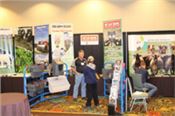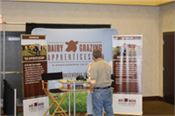|
Dairy Grazing Conference Highlights Innovation
TERRY SIMMONS
JONESBORO, ARK.
Nearly 200 regional dairy producers and grazing experts from around the world assembled on July 7th and 8th for the 2015 Missouri Dairy Grazing Conference. The conference was held at the Ramada Hotel and Oasis Conference Center in Springfield, Missouri.
Grazing dairies make low-cost milk by cutting feed, harvest and storage costs. Another appeal is less labor on the part of producers. Dairy farming offers a way for young farmers to get started in farming. According to Joe Horner, University of Missouri Extension Dairy Economist, “Missouri, with plentiful feed and good forage-growing climate, provides options to producers.”
Day one of the conference was spent “in the field” with participants taking a bus tour of four different dairies in the Southwest Missouri area. The tour featured exhibitions and discussion of irrigation systems for pastures, production of various types of grazing forages, animal management, cost-benefit considerations, staffing levels, and employee management for different grazing setups.
Day two began with the opening of the trade show floor, which was crowded with participants obtaining information from the many exhibitors. Organizations that promote and support dairies, as well as private consultants, manufacturers and government entities filled the trade show area.
The general sessions began with a welcome from Dr. David Baker, Assistant Dean, University of Missouri Extension. After his welcome, Dr. Dean, who is retiring this year, was presented with gifts from other extension colleagues.
Dr. Stacey Hamilton, University of Missouri Extension, presented first at the session on the various risk and reward considerations faced by grazing-based dairy producers. Dr. Hamilton said that the goals of the grazing program from the beginning had been to “maintain the quality of life in Southwest Missouri, grow the dairy industry, and expand the tool box of available choices for producers.” Dr. Hamilton said that producers “wanted to make a living and provide a future for their families without having to milk cows 365 days a year.”
Dr. David Combs, University of Wisconsin Professor of Dairy Science, presented next on Wisconsin’s patented TTNDFD system (Total Tract Neural Detergent Fiber Digestibility). Dr. Combs presented various data on digestion and nutrient uptake of various feed sources in dairy herds.
The afternoon session began with Mike Trammell, Plant Breeder from the Samuel Roberts Noble Foundation. The Noble Foundation’s forage breeding program is one of its longest running and most successful programs. The Noble Foundation released four new small grain varieties this , building on more than 60 years work in plant breeding for cattle.
The afternoon session wrapped up with a presentation by Colten Green of Genex Cooperative, Inc. Green discussed the costs and benefits of breeding beef bulls with dairy heifers. Over the past 30 months, Genex has marketed more than 300,000 units of beef semen to dairy herds. According to Green, “Strategic incorporation of beef semen into dairies enables producers to expedite genetic progress by simultaneously increasing selection intensity of desired traits and decreasing the generation interval within a herd.”
According to organizers, the biennial Missouri Dairy Grazing Conference continues to grow in popularity because of presentations of the newest available technologies and the fact that “farmers like to learn from farmers who make successes of their farms.” ∆
TERRY SIMMONS: Contributing Editor/Farm Director at Ag Watch Network


|
|